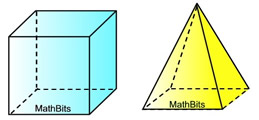|
Directions: Read carefully and choose the best answer.
1. |
Given a right circular cone.
|
|
|
a) What is the shape of a cross section parallel to the base of the cone? |
|
|
b) What is the shape of a cross section perpendicular to the base of the cone? |
Choose:
|
|
2. |
A right square pyramid sits atop a right circular cylinder as shown at the right. A sword will make a vertical slice through both figures starting at the vertex of the pyramid. Which of the following shapes represents the cross section? |
|
|
|
3. |
Of the choices "square", "rectangle" and "triangle", which of the following are possible cross sections obtained when slicing a cube?
|
|
|
Choose:
|
|
4. |
Given a right triangular prism as shown at the right. A cross section is made parallel to the bases. Which of the following statements is true regarding the area of the cross section and the area of the base? |
|
| |
Choose:
|
|
5. |
Given a right circular cylinder with a radius of 8 inches and a height of 20 inches. Which of the following choices is NOT a possible cross section of this cylinder? |
|
|
|
|
Which of the following statements is FALSE regarding possible cross sections when slicing a right square pyramid?
|
Choose:
|
|
7. |
Given a cube. A cross section is sliced diagonally through the center of the cube, as shown. Which of the following statements is true regarding the area of the cross section and the area of the cube's face?
|
|
Choose:
|
|
8. |
A plane intersects a sphere. (The plane is not tangent to the sphere.) Which of the following statements is true regarding the cross section formed by the plane? |
|
|
|
9. |
A solid has a triangle as a cross section. Which of the following solids could NOT have a triangle as a cross section? |
Choose:
|
|
10. |
A cube and a right square pyramid are sitting on a flat surface. Which of the following statements are true?
(Check all that apply, and hit SUBMIT!) |
 |
|
| |
|

NOTE: The re-posting of materials (in part or whole) from this site to the Internet
is copyright violation
and is not considered "fair use" for educators. Please read the "Terms of Use". |
|